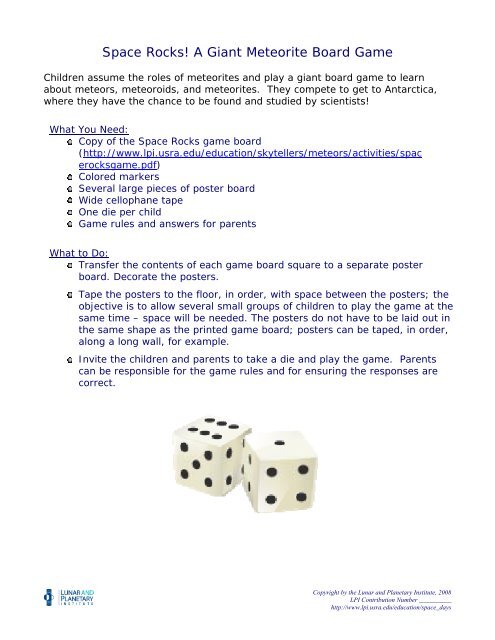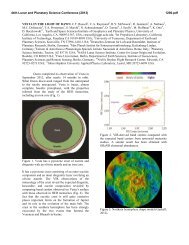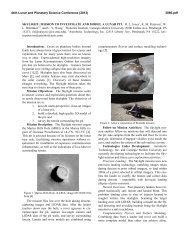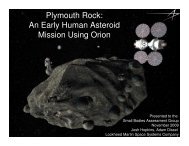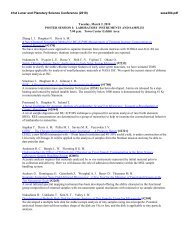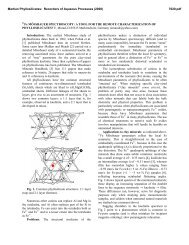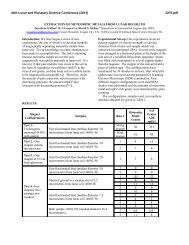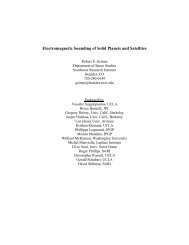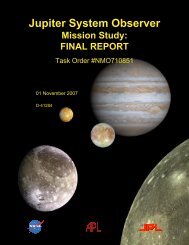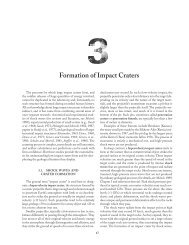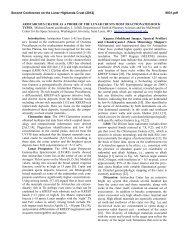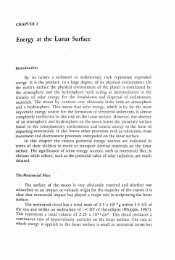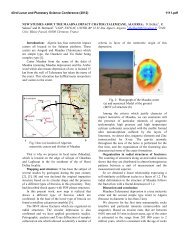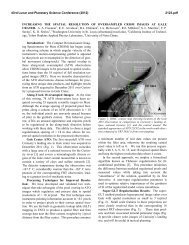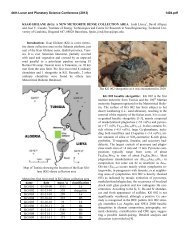Space Rocks! A Giant Meteorite Board Game - Lunar and Planetary ...
Space Rocks! A Giant Meteorite Board Game - Lunar and Planetary ...
Space Rocks! A Giant Meteorite Board Game - Lunar and Planetary ...
Create successful ePaper yourself
Turn your PDF publications into a flip-book with our unique Google optimized e-Paper software.
<strong>Space</strong> <strong>Rocks</strong>! A <strong>Giant</strong> <strong>Meteorite</strong> <strong>Board</strong> <strong>Game</strong><br />
Children assume the roles of meteorites <strong>and</strong> play a giant board game to learn<br />
about meteors, meteoroids, <strong>and</strong> meteorites. They compete to get to Antarctica,<br />
where they have the chance to be found <strong>and</strong> studied by scientists!<br />
What You Need:<br />
Copy of the <strong>Space</strong> <strong>Rocks</strong> game board<br />
(http://www.lpi.usra.edu/education/skytellers/meteors/activities/spac<br />
erocksgame.pdf)<br />
Colored markers<br />
Several large pieces of poster board<br />
Wide cellophane tape<br />
One die per child<br />
<strong>Game</strong> rules <strong>and</strong> answers for parents<br />
What to Do:<br />
Transfer the contents of each game board square to a separate poster<br />
board. Decorate the posters.<br />
Tape the posters to the floor, in order, with space between the posters; the<br />
objective is to allow several small groups of children to play the game at the<br />
same time – space will be needed. The posters do not have to be laid out in<br />
the same shape as the printed game board; posters can be taped, in order,<br />
along a long wall, for example.<br />
Invite the children <strong>and</strong> parents to take a die <strong>and</strong> play the game. Parents<br />
can be responsible for the game rules <strong>and</strong> for ensuring the responses are<br />
correct.<br />
Copyright by the <strong>Lunar</strong> <strong>and</strong> <strong>Planetary</strong> Institute, 2008<br />
LPI Contribution Number __________<br />
http://www.lpi.usra.edu/education/space_days
<strong>Space</strong> <strong>Rocks</strong>! A <strong>Giant</strong> <strong>Meteorite</strong> <strong>Board</strong> <strong>Game</strong><br />
<strong>Game</strong> Rules<br />
Players begin in “The Meteoroid Zone,” above Earth’s atmosphere. They progress<br />
to “The Meteor Zone,” where particles enter Earth’s atmosphere <strong>and</strong> create<br />
brilliant streaks of light (meteors) as they race toward Earth’s surface. Most burn<br />
up completely. Finally, they reach the “The <strong>Meteorite</strong> Zone,” those rocks from<br />
space that passed through Earth’s atmosphere without being vaporized may be<br />
found as meteorites.<br />
The children’s mission is to – as meteoroids - pass through Earth’s atmosphere<br />
<strong>and</strong> reach Earth as a meteorite, where they can be found <strong>and</strong> tell their story to<br />
scientists.<br />
Have each child begin as a “Meteoroid” on the “Start” square. Each child, in turn,<br />
will roll the die <strong>and</strong> move themselves the appropriate number of spaces. They are<br />
to follow the directions on the initial square on which they l<strong>and</strong>.<br />
“Query squares” have questions for the children to answer. When he or she<br />
answers correctly, as verified by the parent, he or she may advance to the next<br />
square <strong>and</strong> wait for his or her next turn to roll the die.<br />
If a player answers incorrectly, he or she must remain on that square until their<br />
next turn <strong>and</strong> then try again to answer that same question correctly. Once they<br />
have answered correctly, they may advance to the next square <strong>and</strong> await their<br />
next turn.<br />
As the children complete a track, they move to the next track. To win, the child<br />
must roll — in turn — until he or she l<strong>and</strong>s on the last square in “Antarctica,”<br />
where they may be discovered <strong>and</strong> studied by a team of scientists, <strong>and</strong> perhaps<br />
reveal clues to the mysteries of our early solar system!<br />
Copyright by the <strong>Lunar</strong> <strong>and</strong> <strong>Planetary</strong> Institute, 2008<br />
LPI Contribution Number __________<br />
http://www.lpi.usra.edu/education/space_days
<strong>Space</strong> <strong>Rocks</strong>! A <strong>Giant</strong> <strong>Meteorite</strong> <strong>Board</strong> <strong>Game</strong> Answers<br />
Meteoroid Zone<br />
A meteoroid can be a piece of what?<br />
a. the Moon or Mars b. an asteroid c. a comet d. all of the above<br />
Are meteoroids really “shooting stars”?<br />
No. Meteoroids do not have trails of light because they are not moving through Earth’s<br />
atmosphere. Meteors, not meteoroids, are called shooting stars, but they are not really stars at all,<br />
either.<br />
What is a meteoroid?<br />
a. a rock from space found on Earth b. a small minor planet c. a tiny particle, often no<br />
bigger than a grain of s<strong>and</strong>, orbiting around the Sun<br />
What does a meteoroid sometimes become?<br />
a. a black hole b. a meteor c. a small planet<br />
Meteoroids are smaller than objects scientists would call small planets. When a meteroid moves<br />
through Earth’s atmosphere, it creates a brilliant streak of light — a meteor.<br />
Often meteoroids are what?<br />
a. the size of planets b. not much larger than a grain of s<strong>and</strong> c. solid gold<br />
A meteoroid can be made of what?<br />
a. metal (typically iron <strong>and</strong> nickel) b. rock c. metal <strong>and</strong> rock d. all of the above<br />
Where do meteoroids NOT occur?<br />
a. throughout our solar system b. in the asteroid belt c. on Earth<br />
Meteoroids are “rocks in space.” When a meteoroid l<strong>and</strong>s on Earth, it is called a meteorite.<br />
Meteor Zone<br />
What causes an “annual” meteor shower?<br />
a. Earth passing through the debris of a particular comet in its orbit b. favorable weather<br />
conditions c. the birthdays of certain astronomers<br />
What are meteors incorrectly called?<br />
a. falling stars b. shooting stars c. fireballs d. all of the above<br />
Meteors are created by particles falling through our atmosphere — they have nothing to do with<br />
stars or fire!<br />
Meteors are often seen as what?<br />
a. particles in space b. streaks of light c. stars<br />
Meteors are the streaks of light we see in the night sky. They are caused by particles moving<br />
through our atmosphere so fast that they compress the air in front of them <strong>and</strong> the air heats up<br />
<strong>and</strong> glows.<br />
What are the names of two famous meteor showers that occur annually?<br />
a. the Alphas <strong>and</strong> the Omegas b. the Leonids <strong>and</strong> the Perseids c. the Hatfields <strong>and</strong> the<br />
McCoys<br />
When Earth’s orbit intersects a comet’s orbit, the particles in the comet’s trail enter Earth’s<br />
atmosphere <strong>and</strong> create meteor showers! The Perseid meteor shower peaks in August <strong>and</strong> radiates<br />
from the constellation of Perseus. It comes from particles in the trail of Comet Swift-Tuttle. The<br />
Leonid meteor shower peaks in November <strong>and</strong> appears to come from the direction of the<br />
constellation Leo.<br />
How many meteors might you see in a meteor shower in an hour?<br />
a. 1 to 2 b. 1,000,000 c. between 10 <strong>and</strong> a few hundred<br />
Comet trails are dusty places!<br />
Copyright by the <strong>Lunar</strong> <strong>and</strong> <strong>Planetary</strong> Institute, 2008<br />
LPI Contribution Number __________<br />
http://www.lpi.usra.edu/education/space_days
Copyright by the <strong>Lunar</strong> <strong>and</strong> <strong>Planetary</strong> Institute, 2008<br />
LPI Contribution Number __________<br />
http://www.lpi.usra.edu/education/space_days


